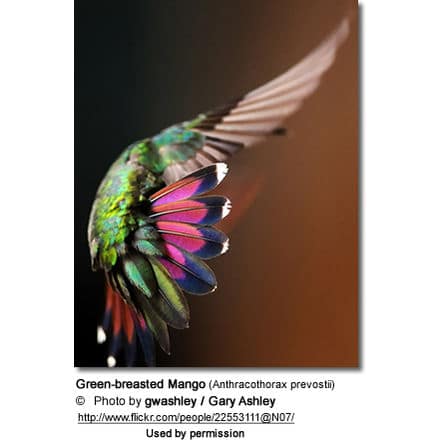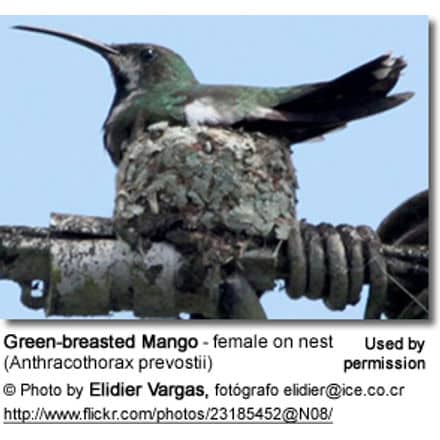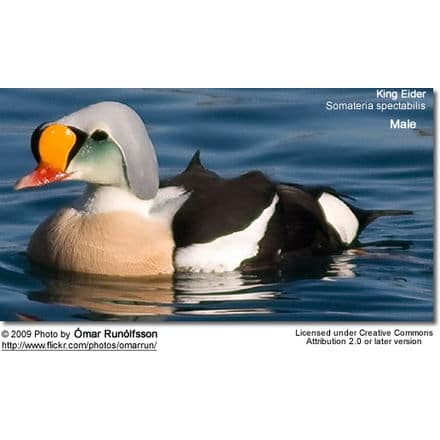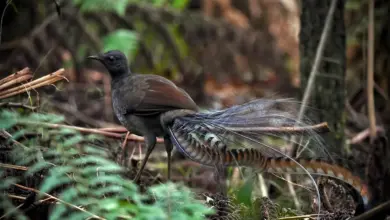Green-breasted Mango
The Green-breasted Mangos (Anthracothorax prevostii) – previously known as Prevost’s Mango – is a large hummingbird that is endemic to tropical America. They occur, for the most part, in Mexico and Central America, but vagrants (mostly juveniles) have also been observed in some areas of the United States.
The Green-breasted Mango and the Veraguan Mango (Anthracothorax veraguensis) were originally considered conspecific, but in 1983 the American Ornithologists’ Union (AOU) split these two species up, based on some physical differences and their different ranges.

Distribution / Habitat
Their natural range extends from eastern and southern Mexico south through Central America – including some islands along the coast – down to Costa Rica.
This species is partially migratory. The Green-breasted Mangos breed in northeastern Mexico from late February through September; and move south for the winter season.
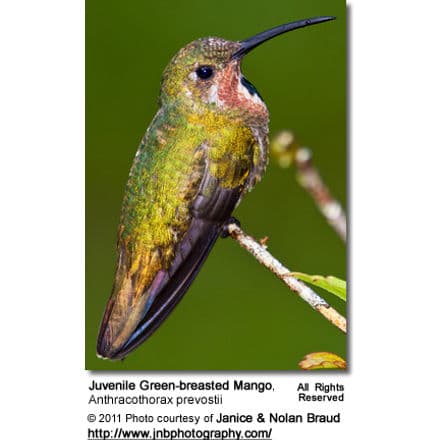
In Mexico, they range from southern Tamaulipas (northeastern Mexico) and San Luis Potos (central Mexico) south to northern Oaxaca and Chiapas (southwestern Mexico), and in Veracruz and the Yucatan Peninsula (southeastern Mexico).
Additionally, they are found on some larger islands offshore, Hunting Cay off Belize, the Bay Islands off Honduras, and on Providencia and San Andre’s islands in the Caribbean Sea off Nicaragua.
They range south to central Costa Rica and northwestern Panama (Bocas del Toro).
Some isolated populations occur along the northern coast of South America from extreme northeastern Colombia through northern Venezuela, in the upper Cauca River Valley of southwestern Colombia, and on the coastal slope of southwestern Ecuador and northwestern Peru.
United States: Immature birds are responsible for the majority of occurrences in the United States.
- Several juveniles have been sighted in southern Texas. The first one was photographed in coastal Texas in Sept. 1988. Since then, it has been sighted in Corpus Christi in January 1992 and some of them have been rare residents in the lower Rio Grande Valley of southern Texas
- The first Green-breasted Mango documented north of Mexico was photographed in coastal Texas in September 1988. The species has since become an increasingly frequent vagrant and extremely rare resident
- A juvenile male in Concord, North Carolina (Nov. 2000)
- A juvenile male in Beloit, Wisconsin (Sept. 2007) – this bird was captured before wintery weather conditions occurred and was transferred to the Brookfield Zoo, near Chicago, which elected to confine the bird permanently
- A juvenile (possibly a male) was sighted in Dublin, Georgia (Oct. 2007)
- Sightings of them exist in Florida.
Habitat
They mostly inhabit tropical deciduous forests in the tropical zone up to an elevation of 1,000 m (~3,300 ft). They are also found in open areas with scattered large trees, orchards, gardens as well as cultivated areas. Its distribution is often localized.
Subspecies and Distribution
- Anthracothorax prevostii prevostii (Lesson, 1832) – Nominate Race
- Range: Eastern and southern Mexico south to Guatemala, Belize and possibly El Salvador
- Anthracothorax prevostii gracilirostris (Ridgway, 1910)
- Range: El Salvador and Honduras south to central Costa Rica
- Range: San Andrés and Providencia islands in the western Caribbean near Nicaragua
- Range: Extreme northeastern Colombia (Guajira Peninsula) and coastal slope of northern Venezuela
- Range: Upper Cauca Valley in western Colombia and along the coastal slope of southwestern Ecuador and in extreme northwestern Peru
Description
It measures about 11-12 cm (4.3 – 4.7 inches) in length, including bill and tail. Males tend to be a little larger, weighing about 7.2 g (0.3 oz), compared to females who average 6.8 g (0.2 oz). They have long, sleek wings and distinctly triangular faces. The bill is black, longish with a slight down-curve.
Most of its body is green, more yellowish brown on its flanks (sides) and vent. There is a broad blue area from its throat to below the chest – which may appear black in poor light conditions.
The outer tail feathers range in color from an orangey-red to magenta or a deep purple tipped with black. In females and juvenile males, the outer tail feathers are broadly banded in magenta and iridescent dark blue, with narrow white tips on the outer 3 to 4 tail feathers.
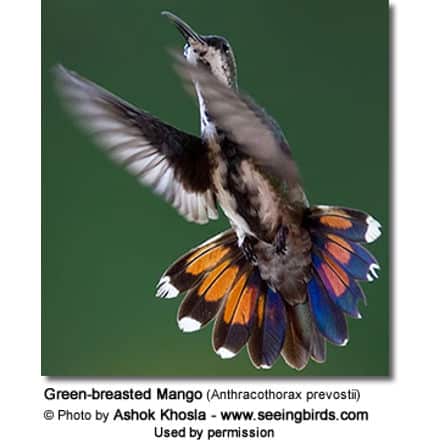
The adult male has glossy bright green upper plumage. His throat and chest have a relatively narrow matte black central area, bordered with blue-green. His flanks (sides) are bright green, and the black of the chest tapers onto the abdomen.
The female has a bronze-green upper plumage and a mostly white under plumage with a dark central stripe that changes from black at the chin to blue-green on the throat.
Like the females, immature birds also have a bronze-green upper plumage and mostly white under plumage with a dark central stripe that changes color from black at the chin to blue-green on the throat. Juveniles also have a distinctive black patch on the abdomen edged in white. They have some grey or buff feather edges on the head and wings, and are mottled with cinnamon to rusty brown along the edges of the white chest-belly stripe. Young females have less extensive magenta in the outer tail feathers than adult females or juvenile males.
Similar Species:
The Green-breasted Mango looks very much like the Colombian Veraguan Mango; however, the latter species has a blue median stripe down the breast – while the Green-breasted’s median stripe is black – this applies to both males and females. However, young Veraguan Mangos have a “more blackish” stripe than their parents, making them difficult to differentiate from the immature Green-breasted.
The Green-breasted Mango also resembles the closely related Black-throated Mango. The male Green-breasted can mostly be differentiated by his less extensive black on the under plumage; however, under certain light conditions, his plumage appears all black – which makes identification difficult. Females of those two species look very much alike — the only difference being the more intense coppery tone of the upper plumage of the Green-breasted females.
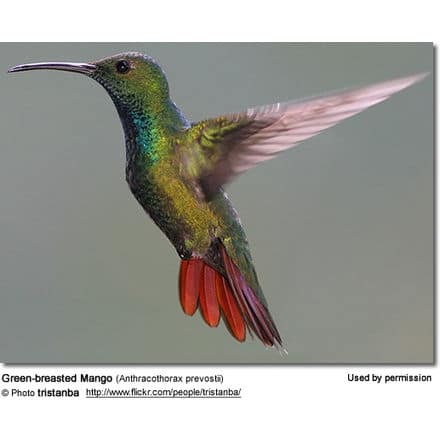
Diet / Feeding
The Green-breasted Mangos primarily feed on nectar taken from a variety of brightly colored, scented small flowers of trees, herbs, shrubs and epiphytes. They favor flowers with the highest sugar content (often red-colored and tubular-shaped) and seek out, and aggressively protect, those areas containing flowers with high energy nectar. Their favorite nectar sources include the flowers of large trees, such as Inga, Erythrina, and Ceiba or kapok.
They use their long, extendible, straw-like tongues to retrieve the nectar while hovering with their tails cocked upward as they are licking at the nectar up to 13 times per second. Sometimes they may be seen hanging on the flower while feeding.
Many native and cultivated plants on whose flowers these birds feed heavily rely on them for pollination. The mostly tubular-shaped flowers actually exclude most bees and butterflies from feeding on them and, subsequently, from pollinating the plants.
They may also visit local hummingbird feeders for some sugar water, or drink out of bird baths or water fountains where they will either hover and sip water as it runs over the edge; or they will perch on the edge and drink – like all the other birds; however, they only remain still for a short moment.
They also take some small spiders and insects – important sources of protein particularly needed during the breeding season to ensure the proper development of their young. Insects are often caught in flight (hawking); snatched off leaves or branches, or are taken from spider webs. A nesting female can capture up to 2,000 insects a day.
Males establish feeding territories, where they aggressively chase away other males as well as large insects – such as bumblebees and hawk moths – that want to feed in their territory. They use aerial flights and intimidating displays to defend their territories.
Nesting / Breeding
Hummingbirds are solitary in all aspects of life other than breeding; and the male’s only involvement in the reproductive process is the actual mating with the female.
They neither live nor migrate in flocks; and there is no pair bond for this species.
Males court females by flying in a u-shaped pattern in front of them. He will separate from the female immediately after copulation. One male may mate with several females.
In all likelihood, the female will also mate with several males. The males do not participate in choosing the nest location, building the nest or raising the chicks.
The female Green-breasted Mango is responsible for building the tiny cup-shaped nest out of plant fibers woven together and green moss on the outside for camouflage in a protected location in a shrub, bush or tree (or as can be seen on the image to the right – they may take advantage of man-made structures).
She lines the nest with soft plant fibers, animal hair and feather down, and strengthens the structure with spider webbing and other sticky material, giving it an elastic quality to allow it to stretch to double its size as the chicks grow and need more room. The nest is typically found on a low, skinny horizontal branch.
The average clutch consists of two white eggs, which she incubates alone for about 16 to 17 days, while the male defends his territory and the flowers he feeds on. The young are born blind, immobile and without any down.
The female alone protects and feeds the chicks with regurgitated food (mostly partially-digested insects since nectar is an insufficient source of protein for the growing chicks). The female pushes the food down the chicks’ throats with her long bill directly into their stomachs.
As is the case with other hummingbird species, the chicks are brooded only the first week or two, and left alone even on cooler nights after about 12 days – probably due to the small nest size. The chicks leave the nest when they are about 24 days old.
Their nests have been observed on trees that were beset with Pseudomyrmex stinging ants. It is possible that these hummingbirds deliberately select such trees for nesting in order to deter predators.
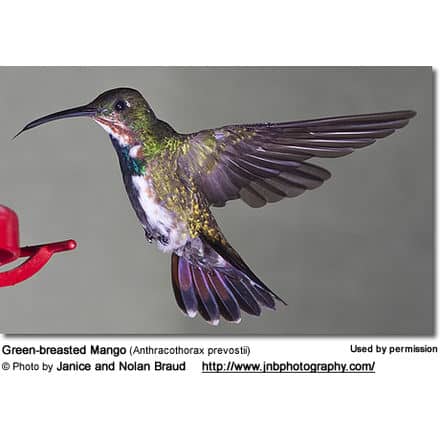
Calls / Vocalizations
The call of the Green-breasted Mango is a high-pitched tsup, and the song is a buzzing kazick-kazee-kazick-kazee-kazick-kazee-kazick-kazee.
Green-breasted Mango – Global Names
Other Names
Its scientific name, Anthracothorax prevostii, commemorates the French naturalist Florent Prévost.
Internationally, this hummingbird is known as:
Spanish: colibrí garganta negra, colibrí gargante negra, colibrí gorjinegro, Mango de Cuello Verde, Mango Pechiverde, Manguito Colipúrpura, Manguito Pechiverde
Czech: Kolibrík lesklý, kolib?ík lesklý
Danish: Grønbrystet Mango
Dutch: Groenborstmango
German: Grünbrustmango
Finnish: Pensashohtokolibri
French: Mango de Prévost
Italian: Mango pettoverde
Japanese: aomunemango-hachidor
Norwegian: Kullstrupemango
Polish: w?glik czarnogard?y, weglik krawatowy, w?glik krawatowy
Russian: ????????? ???????
Slovak: jagavicka zelenoprsá
Swedish: Grönbröstad mango

